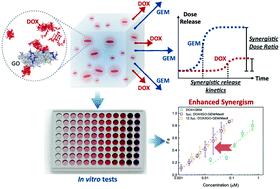当前位置:
X-MOL 学术
›
J. Mater. Chem. B
›
论文详情
Our official English website, www.x-mol.net, welcomes your
feedback! (Note: you will need to create a separate account there.)
Modified gaphene oxide (GO) particles in peptide hydrogels: a hybrid system enabling scheduled delivery of synergistic combinations of chemotherapeutics.
Journal of Materials Chemistry B ( IF 6.1 ) Pub Date : 2020-05-06 , DOI: 10.1039/d0tb00064g John D Schneible 1 , Kaihang Shi 1 , Ashlyn T Young 2 , Srivatsan Ramesh 1 , Nanfei He 3 , Clay E Dowdey 1 , Jean Marie Dubnansky 1 , Radina L Lilova 1 , Wei Gao 3 , Erik Santiso 1 , Michael Daniele 4 , Stefano Menegatti 1
Journal of Materials Chemistry B ( IF 6.1 ) Pub Date : 2020-05-06 , DOI: 10.1039/d0tb00064g John D Schneible 1 , Kaihang Shi 1 , Ashlyn T Young 2 , Srivatsan Ramesh 1 , Nanfei He 3 , Clay E Dowdey 1 , Jean Marie Dubnansky 1 , Radina L Lilova 1 , Wei Gao 3 , Erik Santiso 1 , Michael Daniele 4 , Stefano Menegatti 1
Affiliation

|
The scheduled delivery of synergistic drug combinations is increasingly recognized as highly effective against advanced solid tumors. Of particular interest are composite systems that release a sequence of drugs with defined kinetics and molar ratios to enhance therapeutic effect, while minimizing the dose to patients. In this work, we developed a homogeneous composite comprising modified graphene oxide (GO) nanoparticles embedded in a Max8 peptide hydrogel, which provides controlled kinetics and molar ratios of release of doxorubicin (DOX) and gemcitabine (GEM). First, modified GO nanoparticles (tGO) were designed to afford high DOX loading and sustained release (18.9% over 72 h and 31.4% over 4 weeks). Molecular dynamics simulations were utilized to model the mechanism of DOX loading as a function of surface modification. In parallel, a Max8 hydrogel was developed to release GEM with faster kinetics and achieve a 10-fold molar ratio to DOX. The selected DOX/tGO nanoparticles were suspended in a GEM/Max8 hydrogel matrix, and the resulting composite was tested against a triple negative breast cancer cell line, MDA-MB-231. Notably, the composite formulation afforded a combination index of 0.093 ± 0.001, indicating a much stronger synergism compared to the DOX-GEM combination co-administered in solution (CI = 0.396 ± 0.034).
更新日期:2020-03-03











































 京公网安备 11010802027423号
京公网安备 11010802027423号